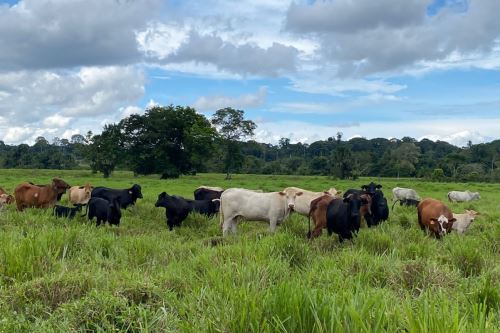By: Jhaen MirandaThe
National Agrarian University La Molina —located in the Peruvian capital, Lima— was the venue for the First International Brangus Congress, a gathering that brought together representatives from livestock associations of the United States, Argentina, Brazil, Uruguay, and Paraguay, with a clear objective: to position genetics as a pillar for sustainable development of Peruvian livestock.
Luis Riquelme Huayanay, Chairman of the Board of Directors at the Peruvian Association of Brangus Breeders (APC Brangus), was emphatic in pointing out that livestock growth in Peru cannot follow the same extractivist pattern of the past.
"We have not come to cut down more jungle, to degrade the soils; on the contrary, we want to recover productive capacity," he stated.
According to Riquelme, regenerative livestock farming and the use of breeds like Brangus can offer a viable alternative to produce high-quality meat in tropical climates without sacrificing sustainability.
In that sense, he highlighted that neighboring countries like Argentina and Brazil already have established breeds, while in Peru, crossbreeding between Creole cattle and other breeds still predominates, which limits productive efficiency.
"We have land, we have resources that are already being used for livestock activity, but they are not being used optimally," he added.
The Brangus breed in the cattle sector stands out for its versatility and high meat production —referred to as live weight per day, according to engineer Riquelme— as well as its longevity, early maturity, and superior meat quality.
"We are recognized as one of the best culinary destinations in the world, but with the meat we had. Poor-quality meat. What would happen if we improved? We would climb two or three steps in terms of quality," he said.
Better genetics, better meat
The congress also featured April Villareal, a rancher and co-chair of the U.S. Committee of the International Brangus Breeders Association (IBBA Brangus).
Villareal highlighted the importance of applying genetic technology to optimize animal selection processes in Peru.
"The most commonly used tool in the United States —and one we can also use here— is EPDs. There, you can get a very good idea of what you are going to produce," she explained.
"Genetically, we extract this DNA; it is improved. It’s called Genetically Enhanced EPDs (Expected Progeny Differences), and it allows us to know exactly what will be produced (…). We want to be able to send the best here."
Villareal mentioned that in the U.S. some farms opt for technologies such as chips embedded in ear tags to monitor the body temperature of cattle, which facilitates detecting heat and scheduling reproduction more efficiently.
"If a breeder produces better meat and gives it to the consumer, the consumer needs to notice a difference, to be shown the difference between the taste of veal, how juicy improved meat can be compared to what they’re usually getting," she pointed out.

AI in livestock farming
For Garrett Thomas, President of the International Committee of IBBA, advancements in genetics must be accompanied by planning and data analysis — areas where tools like artificial intelligence will play a key role.
"Today, we manage enormous volumes of data that need to be analyzed, and the use of artificial intelligence is going to allow us to process that information much more efficiently," he noted.
"I have already seen it in practice: for example, in performing genetic audits. With all that data available, AI can help us identify much faster the highest-performing animals (…). The idea is that we can input that information into a system and it tells us: 'These are the cows you should keep, they are the ones generating income for you; these others are not.' We can already do that today, but with artificial intelligence, the process will be much faster and more effective," the committee president explained.
Thomas emphasized the importance of making strategic genetic decisions from the beginning, especially in diverse environments like Peru, where unique challenges exist.
"I am in favor of using artificial insemination and importing semen. But if we want to achieve real impact, quickly and efficiently, the best path is probably through the use of embryos. That allows you to access a genetically proven product," he stated.
National proposal
Currently, APC Brangus is working with artificial insemination and beginning to introduce high-genetic-value embryos.
However, Riquelme warns that the high costs and bureaucratic procedures limit access for small and medium-sized livestock producers.
"We need embryos to enter Peru without VAT […]. We need Peru to declare a livestock emergency and to allow access to genetic material from any country," he stated.
The APC Brangus president hopes that the genetics developed over 30 to 40 years by other countries can help shorten the path toward more efficient and sustainable production.
The congress held at the National Agrarian University La Molina helped establish ties with Brangus associations from across the Americas, which, according to the organizers, presents a unique opportunity for Peru to develop more specialized, profitable livestock farming aligned with international standards.

(END) JMP/MVB
Published: 6/27/2025